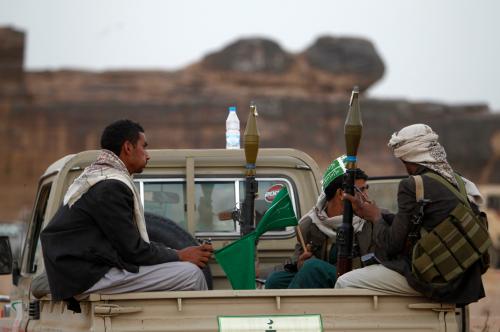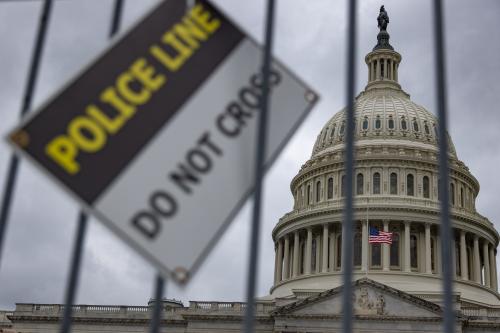This April, the U.N. General Assembly will meet for a Special Session on the World Drug Problem. After decades of conformity with a hardline “war on drugs” formerly promoted by the United States, there is increasing dissensus within the international community about how to best address the costs and harms posed by drugs. For years, some European countries have quietly diverged from policies based on aggressive suppression of drug production and the criminalization of users. More recently, some key Latin American states have openly challenged the global counternarcotics regime and called for reforms.
Yet the Middle East and North Africa (MENA) states still cling to hardline drug policies, an approach that is also supported by Russia and many Asian countries.
On March 7 in Doha, we met with police and military officials, NGO representatives, and academics from across the Middle East to discuss the rising drug challenges in the region and the increasingly contested global regime. We found the Middle East and North Africa are grappling with intensifying drug problem—increased use, spread of drug-related communicable diseases, and widening linkages between drug production and smuggling and violent conflict and terrorism. And there is a growing sense that the repressive policies against illicit drugs long-applied in the region have not been effective in counteracting these negative trends.
Ugly trends, ugly policies
MENA countries have by and large not taken an active or vocal role in global drug discussions. Many governments do not collect or disclose data on levels of drug production, trafficking, and use. Drugs are a social taboo, with little public or government attention to the problem. In fact, the region’s drug policies are most notable for extraordinarily high levels executions of accused drug traffickers—in the hundreds per year in Saudi Arabia and Iran. This policy is increasingly rejected by the international community, even by the stringent International Narcotics Control Board. Even very small possessions of medications such as codeine can be deemed illegal in the region, such as in Dubai, and result in imprisonment or worse.
Despite poor data, there is nonetheless a sense that drug use is on the rise in MENA. The abuse of Captagon in Saudi Arabia has been known for years, and for decades Iran has been among the world’s largest consumer countries of opiates. Drug use could well be on the rise elsewhere in Iraq and Syria, although records are kept poorly or not at all. Bored, unemployed, frustrated young people and war-traumatized dislocated populations are understandably vulnerable to the temporary escape offered by drugs.
[R]ecords are kept poorly or not at all.
Refugees pose a new challenge for states designing policies to address drug use. Immiserated, segregated, and lacking legal economic options, some in the refugee populations may find employment in the Middle East’s long established drug smuggling networks. Badly-integrated and highly marginalized diaspora communities often have small segments that become crucial vectors of international smuggling. Unfortunately, some governments in the region have responded by denying—wrongly—humanitarian non-governmental organizations’ authorization to distribute crucial palliative and mental illness medications for fear that these will be diverted into the illicit economy.
Prevention policies have been largely ineffective in containing rising drug use. Drug treatment is underprovided throughout the region. In the Gulf, even relatively progressive Qatar established its first drug treatment center only in the past few years. Conservative societies in the region tend to stigmatize users, so few seek out help. Consequently, the spread of HIV/AIDS and hepatitis among intravenous drug users has not been contained.
Badly-integrated and highly marginalized diaspora communities often have small segments that become crucial vectors of international smuggling.
Cash for militants, cash for the poor
In the Middle East, drug production and trafficking has long funded violent conflict. In Lebanon, for example, Hezbollah and various sectarian militias taxed the cultivation of marijuana and opium poppy in the Bekaa Valley beginning in the 1970s. ISIS now appears to be smuggling local weed too. Efforts to eradicate the crops and provide alternative livelihoods for the valley’s poor farmers have ebbed and flowed, depending on pressures from international community. Alternative development policies have often been cast too narrowly and have relied on questionable substitute crops such as tobacco.
Synthetic drugs are also a problem for the region, particularly where poorly governed or ungoverned areas provide cover for laboratories. The production of Captagon is increasing in Lebanon and it is even more widely produced in Syria, where it is smuggled and taxed by ISIS for revenue. ISIS fighters are also alleged to consume Captagon to increase their fighting prowess and brutality (echoing amphetamine-fueled violence by West African fighters in the 1990s). Drug trafficking has funded terrorists and militias in Libya, most notably Mokthar Belmokthar’s terrorist group. This group has taxed a broad range of smuggled goods, but its narcotics that captures the headlines.
Alternative development policies have often been cast too narrowly and have relied on questionable substitute crops such as tobacco.
The region also experiences problems with legal drugs, such as qat in Yemen. While qat is culturally acceptable, it decreases productivity of users, increases family indebtedness, and causes severe overexploitation of scarce water resources to support its cultivation. Yemen’s water scarcity is one of the largest in the world. For many women in Somalia during the Shabab era (and today in places such as Djibouti), peddling qat was the only source of livelihood even as it made their husbands unproductive and drove households into high debt.
But suppressing production and trade may not be politically or economically sustainable, as even the terrorist group al-Shabab learned in Somalia when it tried to disrupt qat trading. Like with its 1990s predecessor al-Itihaad, prohibition of qat use and trade caused al-Shabab to lose crucial support from influential business leaders and clan chiefs, undermining the political entrenchment of the group.
Bright spots?
There are some positive counter-examples in the region. Recognizing that its highly punitive policies have failed, Iran has adopted some important harm-reduction measures even while clinging to executions and even though many treatment centers, especially for women, have to operate hidden from view. Along with Morocco, it has been experimenting with methadone maintenance, needle exchange, and other harm reduction measures as well as ways to improve the effectiveness of treatment. Some 420,000 Iranian addicts are reported to receive methadone maintenance and 76,000 buprenorphine treatment. Morocco’s vibrant drug policy conversation even includes civil society voices favoring the legalization of marijuana use and possibly even cultivation, which would a return to the policies in place in the early 20th century. Turkey has been a model since the 1970s of how to produce medicinal opiates and prevent their diversion into the legal drug trade. With the help of U.S. legislation in the 1970s that guaranteed Turkey and India that the United States buys 80 percent of opium for medicinal purposes from these two countries–and with the implementation of very good control practices, such as the use of so-called poppy-straw concentrate method—Turkey eliminated illegal poppy cultivation while keeping its farmers employed. Local militants such as those in the Kurdistan Workers’ Party (PKK) or Turkish criminal groups have never been able to penetrate the legal medical production and instead fund themselves by smuggling opiates from Afghanistan.
In North Africa, Morocco has witnessed a reduction in marijuana cultivation. So there are some cases where well-designed policy responses can have an impact on drug production. Looking further abroad, Thailand—once a major source of drugs in the infamous “Golden Triangle”—offers another positive model for how to wipe out poppy production humanely through a combination of strong economic growth and rural development. MENA governments might look to Thailand for lessons.
[S]ocial taboos, traumatized dislocated populations, state fragility, weakness and corruption of law enforcement, rivalrous geopolitics, and intense conflict all inhibit effective drug policies.
Breaking the cycle
In the Middle East and North Africa, social taboos, traumatized dislocated populations, state fragility, weakness and corruption of law enforcement, rivalrous geopolitics, and intense conflict all inhibit effective drug policies.
If governments and civil society in the region do not start thinking deeply about drug trends and policies, the threats and harms will grow much more intense. Governments and NGOs need to start gathering and disclosing data on drug use and better map drug smuggling. Drug use should be depenalized: Throwing users into jail will not stop use and may facilitate radicalization. Use should be destigmatized and better treatment provided, while public health approaches should also be adopted. If governments force eradication before effective alternative livelihoods are in place, it is likely that farmers will only be further pushed into the arms of militants (and such policies should not be intensified in the Bekaa Valley, for example).
There is no easy way to disrupt terrorist drug funding, the eternal dream of governments around the world. But interdiction can more effectively target the drugs-terrorism nexus. The first step, before all else, is to acknowledge drug challenges are on the rise in the Middle East and that repression is not stopping them.



Commentary
Breaking bad in the Middle East and North Africa: Drugs, militants, and human rights
March 22, 2016